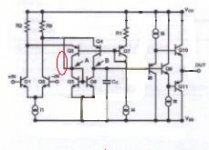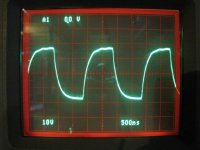FWIW
The uA709
(ss ic version)
was actually much quieter than many other op amps of the time
and even with the class b output pretty fidelious ......
The uA709
(ss ic version)
was actually much quieter than many other op amps of the time
and even with the class b output pretty fidelious ......
I started with the ua702 and 709 in 1966, a long time ago. Interesting designs, but not much to talk about, today. The early Harris devices look more interesting to serious designers.
A thing that always got me was the differance
in the schematics between the LF356 and the
TL072 ...... close to the same specs but the TL072
was way simpler ...... metaphysically drove me
to percieving the sound of the TL072 as better.
in the schematics between the LF356 and the
TL072 ...... close to the same specs but the TL072
was way simpler ...... metaphysically drove me
to percieving the sound of the TL072 as better.
john curl said:I started with the ua702 and 709 in 1966, a long time ago. Interesting designs, but not much to talk about, today. The early Harris devices look more interesting to serious designers.
Wow!
In 1964 I was a twenty year old techie in the Plessey Semi Fab in Swindon UK.
I was running a TI-553 tester trying to wafer probe those little uA702 suckers and package them into flatpacks. Military, made under licence from Fairchild.
Everything was new, the tester, the semi-automatic prober, the whole planar line, me!
A very rapid education in many things - I went on to work for Faitchild Test Systems for 6 years in Europe and out of East Arques Ave.
Sorry, that's OT.
Thanks Cliff for your input. In 1966, I had to get constructed a custom IC tester at Friden, to test the 702's and the 709's. I was a junior engineer (recent BA in physics) in charge of several techs and working under two experienced engineers. We built (tech's wired, I troubleshooted) a test rig straight from a Fairchild Semi App note. My task was to fully test and qualify 30ea ua709's (worth a small fortune then) for linearity, offset, voltage breakdown, etc. It was successful.
My tech associate, Carl Thompson, worked at Fairchild Test systems. In fact, the Vendetta circuit boards were designed on the 1 million dollar computer that they used for this. We do them at home, now, of course.
My tech associate, Carl Thompson, worked at Fairchild Test systems. In fact, the Vendetta circuit boards were designed on the 1 million dollar computer that they used for this. We do them at home, now, of course.
PMA, do you want to analyze any other circuits? I did think that the HA-5110 circuit holds a lot of potential, if it is simplified to its base schematic. In fact, perhaps we could use one of Scott Wurcer's simplified schematics, since it appears to be essentially the same thing and run with that. I will try to find one, if Scott does not put one forward, first.
John, yes, but not now, unfortunately. I am too busy with preparation of production and listening tests. Hopefully in a few days or next week. I have known that the HA-5110 was/is a remarkable circuit.
BTW, this simplified here is pretty similar to AD817 or 829, except for simpler CCS, I had analyzed them in deep.
BTW, this simplified here is pretty similar to AD817 or 829, except for simpler CCS, I had analyzed them in deep.
dimitri said:HA 5110 simplified, courtesy of John Curl:
Hi Dimitri,
Are you sure the schematic is correct?
See red ellipsis.
Cheers,
Edmond.
Attachments
Thanks for bringing that out, Edmond. Actually there is NO connection, but it appears as one. I will try to make it clearer.
>The early Harris devices look more
>interesting to serious designers.
I think possibly they had the first good complementary
monolythic devices, because I remember one of their
op-amps being the first time I saw a complementary
differential input stage .....
>interesting to serious designers.
I think possibly they had the first good complementary
monolythic devices, because I remember one of their
op-amps being the first time I saw a complementary
differential input stage .....
PMA said:I meant generallly used simplification as VFB, usually dominant-pole compensated device, with low roll-off corner and with very strong NFB. BTW, I have recently made interesting simulations of PIM, that is inherent to this structure, only a question of measure.
Pavel,
This is the step response of one of my purely opamp based line preamps. Not "dominant pole compensated" and of course not slew rate limited. Do you need me to calculate the slew rate?
I can't measure any distortions (and my lower limit is -130dB) on this preamp, including the much feared 7th. Noise is around 5nV/rtHz (remeber, this is a line preamp).
Fits in less than 1 sq inch of SMD PCB. The details will be published on my site ASAP.
How's that? Think it's good enough for audio? The cost (in SMD parts and PCB, without power supply) was around $10.
Edit: gain is set to 10.
Attachments
- Status
- Not open for further replies.
- Home
- Amplifiers
- Solid State
- John Curl's Blowtorch preamplifier



